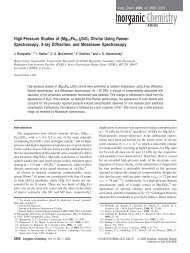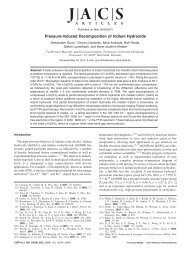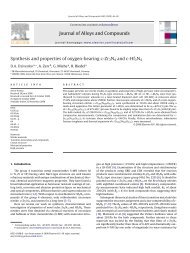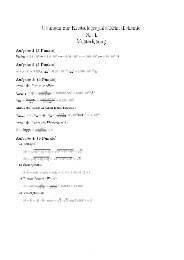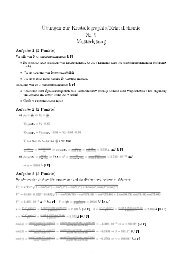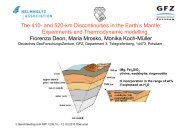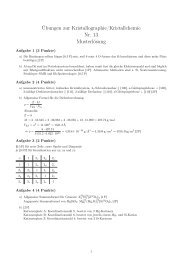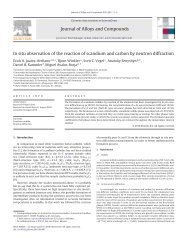Raman spectroscopic study of PbCO3 at high pressures and ...
Raman spectroscopic study of PbCO3 at high pressures and ...
Raman spectroscopic study of PbCO3 at high pressures and ...
You also want an ePaper? Increase the reach of your titles
YUMPU automatically turns print PDFs into web optimized ePapers that Google loves.
Fig. 2 Pressure-induced mode<br />
shifts <strong>of</strong> internal vibr<strong>at</strong>ions on<br />
compression <strong>at</strong> ambient<br />
temper<strong>at</strong>ure in different<br />
experiments runs: a v 1 (filled<br />
circle), v 1 0 (filled triangle)<br />
asymmetric vibr<strong>at</strong>ions; b v 2-out<strong>of</strong>-plane<br />
b<strong>and</strong> (filled circle);<br />
c v 4-in-plane b<strong>and</strong> [1 B 3g (open<br />
circle), 2 A 1g (filled circle),<br />
3 B 2g (filled square), 4 B 1g (filled<br />
triangle)]; d v 2 0 -out-<strong>of</strong>-plane b<strong>and</strong><br />
(open circle). I, II, III indic<strong>at</strong>e<br />
the supposed fields <strong>of</strong> the<br />
existence <strong>of</strong> phases I, II, III.<br />
Colors indic<strong>at</strong>e the run number<br />
<strong>of</strong> the experiments: green the<br />
first, red the second <strong>and</strong> black<br />
the third. The first run was<br />
carried out up to 9 GPa, the<br />
second up to 14 GPa <strong>and</strong> the<br />
third up to 15.6 GPa. The size<br />
<strong>of</strong> the symbols corresponds to<br />
errors in <strong>Raman</strong> shift <strong>and</strong><br />
pressure in c <strong>and</strong> in P in a, b, d<br />
A neg<strong>at</strong>ive linear slope <strong>of</strong> -1.38(7) cm -1 /GPa is observed<br />
up to 6.4 GPa. Thereafter the peak position stays roughly<br />
constant up to 8.8 GPa, dv/dP being -0.32(5) cm -1 /GPa.<br />
From about 8.8(2) GPa up to 11.5(2) GPa the neg<strong>at</strong>ive<br />
average slope is much stronger, -2.86(20) cm -1 /GPa. A<br />
last change <strong>of</strong> the slope is observed <strong>at</strong> 11.5(2) GPa where<br />
dv/dP decreases to -1.74(4) cm -1 /GPa.<br />
The behavior <strong>of</strong> the v 4-in-plane bending modes consisting<br />
<strong>of</strong> four lines (Table 1) is non-monotonic (Fig. 2c).<br />
Only B1g increases linearly with increasing pressure <strong>and</strong><br />
disappears <strong>at</strong> about 8.9(2) GPa (4 in Fig. 1, triangles in<br />
Fig. 2c). The behavior <strong>of</strong> the modes is listed quantit<strong>at</strong>ively<br />
in Table 2. Three pressure ranges can be distinguished in<br />
which the v 4-in-plane b<strong>and</strong>s have different dv/dP values.<br />
Only small hysteresis effects could be observed upon<br />
pressure release within the uncertainty <strong>of</strong> our experiment.<br />
The B 1g in-plane bending re-appears <strong>at</strong> some lower<br />
123<br />
(a) (b)<br />
(c)<br />
v 1<br />
v 1 '<br />
(d)<br />
Table 2 Comparison <strong>of</strong> the dv/dP values <strong>of</strong> v 4 modes in different<br />
pressure ranges<br />
v 4 Mode Pressure<br />
range (GPa)<br />
Phys Chem Minerals<br />
dv/dP<br />
(cm -1 /GPa)<br />
1(B3g) 0–6.40 0.72 (9)<br />
6.4–12 4.40 (15)<br />
12–15.4 2.24 (11)<br />
2(A1g) 0–6.4 0.98 (3)<br />
6.4–10.4 2.33 (18)<br />
10.4–15.4 -0.02 (9)<br />
3(B2g) 0–6.4 1.74 (9)<br />
6.4–12 3.44 (20)<br />
12–15.4 2.15 (8)<br />
4(B1g) 0–9.0 2.60 (6)<br />
St<strong>and</strong>ard devi<strong>at</strong>ions <strong>of</strong> the linear fits to the dv/dP values are given in<br />
parentheses



